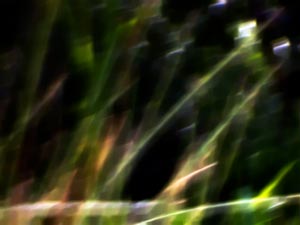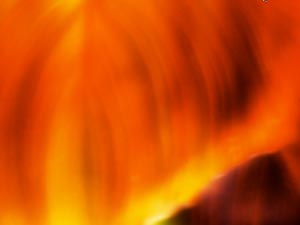The problem with technology is that “something even better” will almost inevitably come out – often after you’ve already pulled the trigger and bought something you thought was more than sufficient. Case in point: I just bought a Canon 5D Mark II (and love it), but Canon has just announced the 7D
(which looks awfully good on paper – maybe “even better”). Excuse me for a moment while I wrestle with my personal demons on the subject (or failing that, enjoy Philip Bloom’s lovely test video on Vimeo, shot with a 7D – more on that later).
Although I have been involved in motion graphics since the early 90s, truth is I rarely shoot my own footage – I’m usually trying to make someone else’s footage look sexy. (The exception: Some stock footage libraries I created for Artbeats and iStock, mostly shot on an ancient Canon Optura placed well out of focus and processed to death).
Even a primitive DV camera can create nice imagery if you push it really hard – and post-process the heck out of it. Note the unusual bokeh (lens blur) caused by the Optura’s thin triangular shutter.
I shoot far more still images – for use in motion graphics, fine art, and nature presentations. Trish and I have moved up through the ranks from the Apple QuickTake (640×480, JPEGed so heavily you could just about make out what you were trying to shoot) up to a Canon 10D DSLR. With the acquisition of a 24″ archival inkjet printer at the start of the year (an HP Z3100, if you’re curious – great for photographic prints; problematic for mixed media work), I’ve been in the market for a still image camera with more pixels. And if it could shoot HD video, so much the better!
Given the above, it’s obvious that I would gravitate to the Canon 5D mkII: we already had an investment in Canon photography lenses, the holy grail for a DSLR owner is a “full frame” sensor (which Canon’s 1D and 5D have) so that lenses work they way they do on an analog SLR, and it shoots more than passable HD video. I wasn’t too bothered by the 30 fps frame rate, as I was already a big fan of 30p as a format, and I don’t mind shooting dual-system audio if needed (I was an audio guy in my previous life). I briefly looked at getting a RED Scarlet with a 5k sensor (to equal the still capabilities of the 5D mkII), but it was a lot more expensive, and still not here yet.
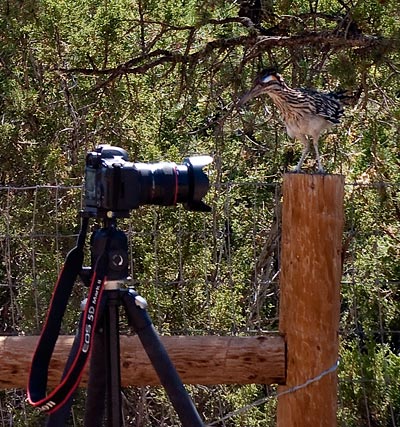
One of our local roadrunners ponders if I’m using fast enough glass to catch him.
So I finally broke down and bought a 5D mkII a few months ago. I really like it; it’s a fine piece. And like any good tool should, it’s pushed me to be a better photographer and videographer – see the image sequence at the bottom of this blog. (It’s also made me hungry for more lenses and filters; I just got a Canon EF 100-400mm f/4.5-5.6L IS USM
lens today.)
And just as we were getting settled in together, here to break up my honeymoon is the Canon 7D. It costs considerably less (enough to buy another Canon L lens, give or take), and has more flexible frame rates (the 7D supports 29.97, 25, & 23.976 fps at 1920×1080 as well as 59.94 and 50 fps at 1280×720; the 5D supports only 30 fps at 1920×1080), which allows shooting some limited slo-mo by shooting at a higher rate, and conforming the resulting footage to the desired lower rate. On the other hand, my 5D mkII has slightly more pixels in still mode, and slightly better low light sensitivity. Meanwhile, the 7D doesn’t have as dramatic of depth of field; it’s smaller APS-C format sensor still requires a 1.6 multiplier be added to my still image lenses.
But if anyone thought that meant the 7D didn’t shoot really sweet video, they’d be mistaken: Just look at Philip Bloom’s lovely test video featured at the top of this post. The depth of field is still nice and cinematic; the bokeh is gorgeous; also note the slo-mo effect on the juggler. Philip owns two 5D mkIIs, but is already smitten by the 7D, as you can read in his blog.
All that said, I don’t regret buying a 5D mkII. I have it now, I’ve already used its video in a paying gig ($25 counts, right?), I’ve already shot a couple thousand hi-res stills with it, and I’m going to shoot a few hundred more this weekend. And it does shoot lovely stills, plus very nice video. There are still a few bugs in its video to iron out – for example, there’s some gamma shifts in its h.264 movies between QuickTime Pro and After Effects (and this behaviour just changed with OS 10.5.8 and QuickTime 7.6.4), plus aliasing artifacts do crop up every now and then – but if anything, I wish I had just pulled the trigger earlier and bought it right after it came out.
However, if I didn’t own a 5D mkII already, and if my personal priorities were weighted a bit more toward video than stills, I’d probably be waiting on a 7D right now…
Why you don’t leave a video camera in Auto mode: The bright sunlight caused the 5D to flip to a too-fast shutter speed. The resulting frames create a good stop-motion still image sequence, but the video strobes like mad (notice how much motion there is between each subsequent frame – in video, you’d prefer to see motion blur yield some continuity between these frames). Solution? Installing the latest firmware with manual exposure control, plus buying a nice set of neutral density filters to handle high-light situations.






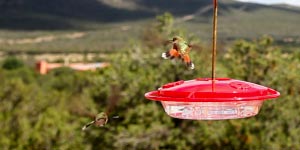
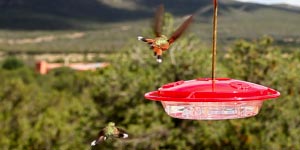
The content contained in our books, videos, blogs, and articles for other sites are all copyright Crish Design, except where otherwise attributed.

Filmtools
Filmmakers go-to destination for pre-production, production & post production equipment!
Shop Now
